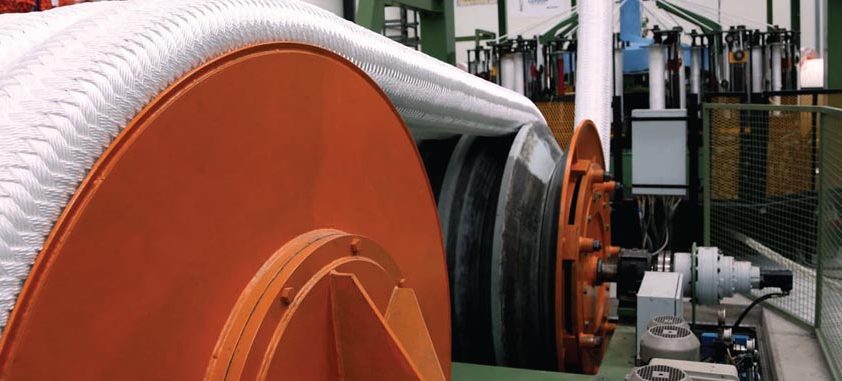
Lankhorst Ropes: Innovating Mooring Systems for Extreme Offshore Environments
Taking the lead
As operators begin exploration and development of oil and gas fields in more demanding offshore environments, Lankhorst Ropes is taking a lead in the development of ‘next generation’ mooring systems, as Neil Schulz, sales director Deepwater Mooring – Lankhorst Ropes Offshore Division, explains in this article.
Drawing on its extensive research and testing facilities at WireCo WorldGroup’s Global Synthetics Lankhorst Euronete R&D facility, the company is researching new mooring rope materials better suited to the engineering and practical challenges of mooring in ultradeepwater and busy fishing areas.
 Cut resistant mooring ropes
Cut resistant mooring ropes
New field development opportunities in the North Atlantic Ocean and Norwegian Sea pose a significant challenge for naval architects. Mooring lines are subject to extreme weather and wave conditions. More concerning, however, is the risk of damage to the mooring lines from fishing trawler activities. Through mooring projects for ENI Norge’s Goliat, and Statoil’s Aasta Hansteen, Lankhorst Ropes has gained an unrivalled insight into production of cut resistant mooring ropes.
Using its in-house rope test machine, Lankhorst has been able to simulate the effect of trawler wires coming into contact with synthetic mooring lines, quantifying the damage and assessing the rope’s residual strength after the event. The results suggest that an over-braided jacket made from DSM Dyneema fibre provides the best means of limiting the damage from trawler wire impact.
Ultra-deepwater HMPE moorings Research by Lankhorst, and strategic technology partner DSM Dyneema, has shown that synthetic ropes made from ultra-low creep high modulus polyethylene (HMPE) fibre hold the key to overcoming the engineering and installation issues facing naval architects and installation contractors deploying ultra-deepwater, permanent moorings.
A new HMPE yarn introduced by DSM, called DM20, has enabled production of a Lankhorst Ropes Gama 98 deepwater rope with less than 0.5 per cent creep elongation over 25 years, meeting industry requirements for permanent mooring systems. HMPE ultradeepwater mooring systems create many more opportunities for production at previously inaccessible water depths. And, although HMPE is more expensive than polyester, this is offset by an overall reduction in mooring system installation costs.
The higher strength DM20 yarn allows smaller diameter ropes for the same MBL compared with polyester. A polyester deepwater rope with a MBL of 1907 tonne has a diameter of 254mm and weighs 43 kg/m, for the same MBL the rope made with DM20 is only 190 mm diameter and weighs 16 kg/m. The smaller diameter and lighter HMPE rope allows more rope per reel, allowing more reels per vessel. And, as fewer reels are needed, these can be more readily handled by an anchor handling vessel. Importantly it will permit the installation of more mooring lines and anchors in one trip, a significant cost saving in vessel size and time when the platform maybe 250 miles offshore.
Another potential installation cost saving is in the area of pre-tensioning. During deepwater mooring system installation, polyester ropes are routinely tensioned using either a specialist, heavy lift, installation vessel or anchor handling vessel to pre-load the rope, increase its stiffness and set the initial bedding-in extension. For a wholly HMPE mooring system this would be unnecessary; although in practice there may be other reasons to apply a higher  load especially with a MODU such as proof testing a vertically loaded anchor.
load especially with a MODU such as proof testing a vertically loaded anchor.
Storm survivability – hybrid ropes
Going further offshore can expose the mooring system to greater wave and current movements, however. Just as the elasticity of polyester is a limiting factor at ultra-deepwater depths, so too can be the stiffness of HMPE. In high storm and hurricane risk areas, the mooring system needs some extension to ensure storm survivability, especially in the Gulf of Mexico. One solution is to use hybrid moorings.
Hybrid mooring lines combine HMPE rope segments with polyester rope segments, to give a mooring that is neither too stiff nor too soft. They allow the mooring system designer to ‘engineer’ the mooring line’s stiffness and use the lengths of polyester and HMPE segments to provide the stiffness needed to handle maximum loads during station-keeping in a storm, while ensuring sufficient elasticity to damp peak loads induced by waves.
The speed of HMPE creep is a function of HMPE type, temperature, mean load and loading time. The preferred hybrid rope configuration is the stiffer HMPE rope in the cooler water close to the seabed, and polyester rope in the warmer waters closer to the vessel. In high storm risk areas, the percentage of HMPE to polyester line lengths used in the hybrid mooring configurations will change as water depth increases, for example, at 1829-m water depth: 50 per cent-50 per cent HMPE/polyester, at 2286-m water depth: 60 per cent-40 per cent HMPE/polyester and at 3048-m water depth: 75 per cent-25 per cent HMPE/polyester.
Of course, as the hybrid mooring system uses polyester this may still need to be pretensioned. However, recent developments in pretensioning practice have suggested that mooring systems designers should only proof test to what they need to ensure the maximum excursion limits are not exceeded and that there is no need to automatically go to 40 per cent MBL, which until now has been the ‘norm’ for deepwater moorings.
Increased mooring systems options
The ability to use HMPE ropes, made from Dyneema DM20, for permanent deepwater moorings is an important development. It is a mooring technology grounded in the need to assist naval architects in striking the right balance between the engineering and economic demands of deploying deepwater moorings. In addition to increasing the scope of synthetic rope for ultra-deepwater moorings, it demonstrates Lankhorst Ropes’ ability to offer a far wider range of mooring options, and with this greater flexibility in the design and engineering of mooring systems.
Lankhorst Ropes
Services: Next generation mooring systems
 Cut resistant mooring ropes
Cut resistant mooring ropes